#we are having a heatwave here in Belgium
Explore tagged Tumblr posts
Note
https://youtu.be/rdcGI31KLzg?si=vReHd9VegXAR01cL Interns, why is Lighting McQueen in the backrooms telling me to pull of my skin?
[Lizzie] (sitting in front of one of the dozen fans scattered around the dorm room) I don't know, why do feel the sick need to find videos like this and send them to us?
[Norma] (On the couch, cold drink in hand, Frazie resting her head on her lap and Raz sitting in front of her feet) Lizzie, be nice.
[Lizzie] Sorry, sorry ...this damn heat.
[Adam] (On a lounge chair, hat covering his eyes) Language.
[Lizzie] English!
[Raz] (Chuckles)
[Frazie] (Fanning herself) When will Gisu finally have the AC fixed?
[Gisu] (From the other side of the wall) IT'LL BE FIXED WHEN I GET IT TO BE FIXED! Have some F-(word unintelligible as the AC makes a loud sound, drowning her out) patience.
[Lizzie] (Laughs) Dang Frazie, you got Gisu to swear.
[Morris] You'd be cranky too if you had to be outside in this heat to fix the AC.
[Norma] Your sacrifice is appreciated, Gisu!
[Gisu] Flip off!
[Raz] (Laughing)
[Sam] I did like the animation of the video. Kinda funny.
[Adam] Thank for your input, Sammy.
[Sam] Anytime. You wanna go swimming?
[Lizzie] I'm down. Gisu, you coming?
[Gisu] (Something heavy drops outside, followed by Gisu cursing) GLADLY!
#we are having a heatwave here in Belgium#AND IT SUCKS!#So the Interns suffer!#psychonauts#psychonauts 2#razputin vodello au#lizzie natividad#norma natividad#sam boole#adam joseph gette#gisu nerumen#morris martinez
7 notes
·
View notes
Text
Wrapping up 2023
It has been a year again with a lot of self-doubts, adventures, self-discoveries, plot twists, falling in love and new potentials discovered.
I started the year promising to myself to cut-off unnecessary people who only cause me pain and self-doubts. All those times I thought I am the problem but to be honest, sometimes people come to our lives only to teach us a lesson and go. That was a hard pill I had to swallow back then.
Back in February, I was able to celebrate my birthday in Hallstatt, Austria. We had a 5 days trip going from Vienna to Hallstatt to Budapest with my colleagues. It was our first trip abroad all together. Even though the cold during that winter time was unbearable, we were able to enjoy it. Hallstatt is such an enchanting place to be.
It was March when I decided to enroll to a swimming class which lasted for 10 to 12 weeks starting on April. It was a fun experience considering I was able to learn proper techniques of swimming and was able to go swim in the ocean, finally. I'm considering to go for another set of lessons this year for intermediate swimmers.
Later that month of March I was also able to meet a guy whom I didn't believe will make a big impact to me now and whom I'll fall in love with.
April, start of Spring. My flatmates and I hiked around Rivera bay and Marsaxlokk. Then on May, for ate Ja's birthday, we went to Venice and Dolomites in Italy. One of the most beautiful places I've been to would definitely be in Dolomites. Sadly, we weren't able to explore and hike all the areas in there since there were still snowy parts in the mountains and still not advisable to go to the top. Nonetheless, it was such a beautiful place.
I remember June as the month when I made it official with Chad. It was also the time when I had the Switzerland trip with Tiffany. Her aunt happily shared their home with us for almost our whole 5 days stay in Schaffhausen, a city an hour away from Zurich. The stories are all true about Switzerland. It has beautiful landscapes, expensive foods, a very good transportation system and has lots of very clean cities. I heard a rumor before going in there that people goes quiet after 10pm and doesn't go for a bath because apparently your neighbors will hear every water that drops in your pipes. The story is true in the sense that some houses in Switzerland have a thin wall where you can hear the other room's small noises especially waterflows and showers.
July and August were peak summer heatwaves here in Malta. I remember going to the beach almost every weekend with Chad and practicing what I learned from my swimming lessons. During these times, I also met some of his friends and him meeting mine.
It was still warm when we went to Paris last September. It was not so much of a good experience with the busses having a freaking heater in the peak of summer. It was exhausting and lots of places to go in such a small time. However, I very much enjoyed my time in Disneyland Paris. It was so magical. I finally saw the famous Eiffel tower, Louvre and Palace de Versailles among such.
The adventure doesn't stop as we went to Spain on October. We explored the cities of Valencia and Barcelona. Valencia has lots of good food while Barcelona has an amazing set of architectural buildings. As someone who adores designs, it was such an eye-candy. We also went to Montserrat mountain.
November was a pretty hectic month with the tax deadlines at work. I was dreaded almost every workday. I already expected it but this year has been tougher than last year's busy season. On the last week of November, I was finally able to have my eye laser procedure. It was life-changing! Imagine me without glasses after wearing one for almost 17 years. It's surreal! Thanks to technology. I'm so happy that I was able to tick that goal in my list.
December was an exciting month since it's Christmas season and we travelled to different Christmas markets in Germany, France and Belgium. Exhausting as it was but very fun times. We have been abroad for 7 days from 21st of December to 27th. It was also Chad's birthday on the 28th and I returned to Malta to be able to celebrate it with him from 28th to 31st December. It was really fun times that I cherish.
Overall, it has been a great year. So many places I explored and people I met. The best thing about this year was unexpectedly meeting and falling in love with Chad. But I'll tell all of that in another post. I still miss my family from time to time 'cause I wasn't able to go home this year, but I'm lucky I got people who makes me feel less lonely and loved wherever they are.
2024, I'm ready for ya!
1 note
·
View note
Text
It’s all about the shade....
7th July - 21st August
We’re having a heatwave, an ongoing heatwave……
It’s hot, hot, hot. Hot, hot, hot.
France and most of Europe are sweltering in an unrelenting heatwave. 100 French regions are officially in drought and many have no drinking water.
After a mild winter with little rain the reservoirs are low and as a consequence the canals are struggling.
Belgium has just closed small canals and pleasure boats like us can only travel the big canals with the commerce who always go first into the locks (as they should).
The water situation in Europe is much worse than 2018.
During July and August our travels along the Marne river have focused on finding shady moorings. Shady tree moorings along a river bank so we can ‘swim’ and cool off.
Not really swim but a cooling dip into the reasonably clean green river.
Daily our minds are occupied working out where the sun was likely to set along the looping Marne.
Most of the official pontoons and quays were always on the sunny side of the river so finding tree moorings with enough depth, the right distance apart, no fishermen and not at the bottom of someone’s garden took time and trials.
Between shade searches we touristified ‘un peu.’
At Meaux we visited the ‘Musee de la Guerre’. Despite its name the museum focused on WW1 along the Marne, not the entire war and emphasised the American contribution in the area. They only arrived in 1917.
The collections were creatively presented although this one, half in and half out of the case, made me jump.
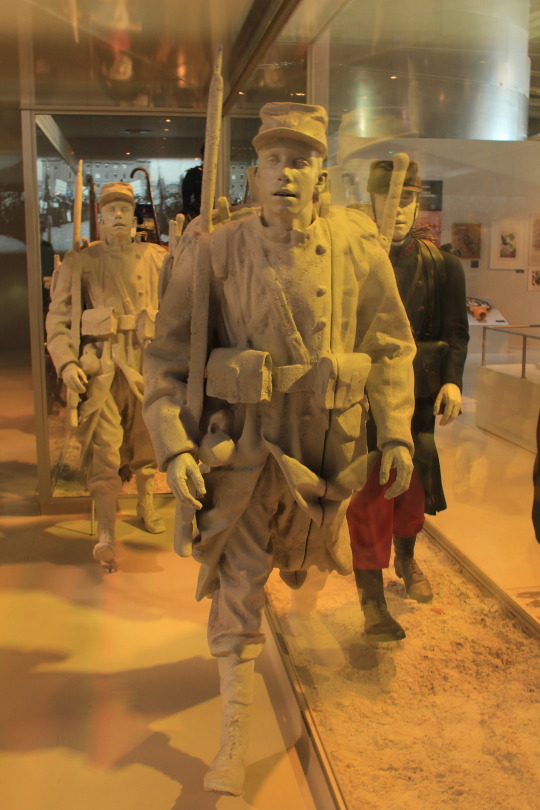

Baldrick and Captain Klink made a surprise visit.
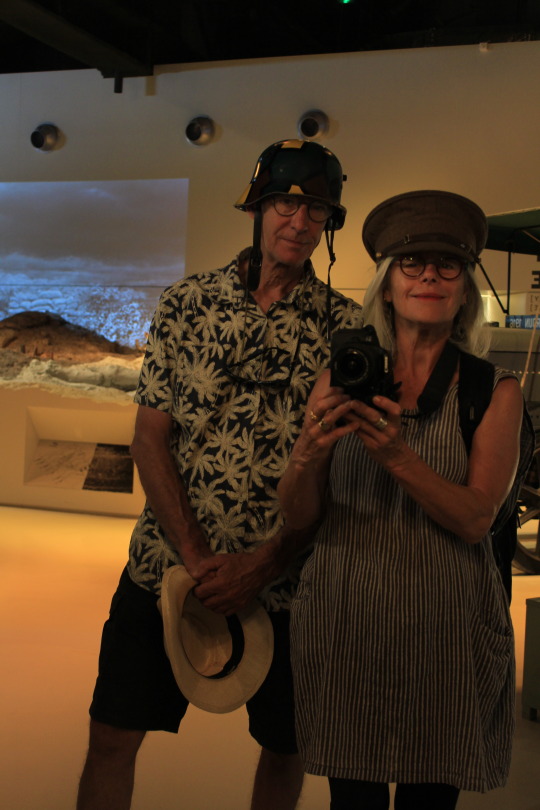
France likes to celebrate Mark’s birthday on July 14 and for once we were here to enjoy the celebrations but it was so Hot!
With temperatures heading north of 37degrees we spent the holiday with our NBF’s (New Best Friends) Peggy and Gary off ‘Viking’. We were partly tied to trees in a forlorn hope of some shade before the sun went down. Mark swam over to the shore to get lines around tree trunks. He wasn’t complaining. Gary very kindly made gf pizzas as a birthday treat.
Here we are having snacks and drinks with Gary and Peggy, their grand daughter and daughter visiting from Toronto.

Chateau-Thierry boasts a fortress first mentioned in 923, as you do. On the hot Sunday we visited a Medieval Fayre was in progress. Apparently Medieval performers only create costumes for cold weather.

Except this one.
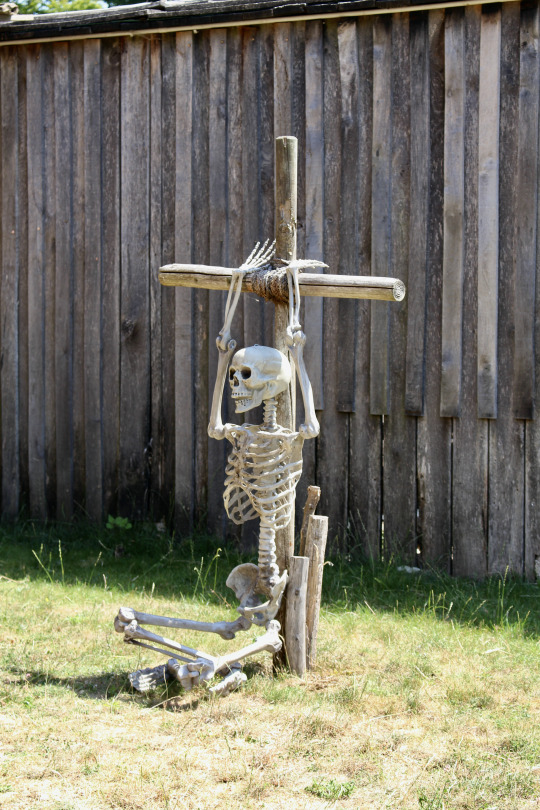
The outstanding modern activity at the fortress is not the eagle display but the tree walk. Mark and other adults greatly outnumbered the few children up in the nets. It was the best place to catch the cooling breezes and to gently bounce.
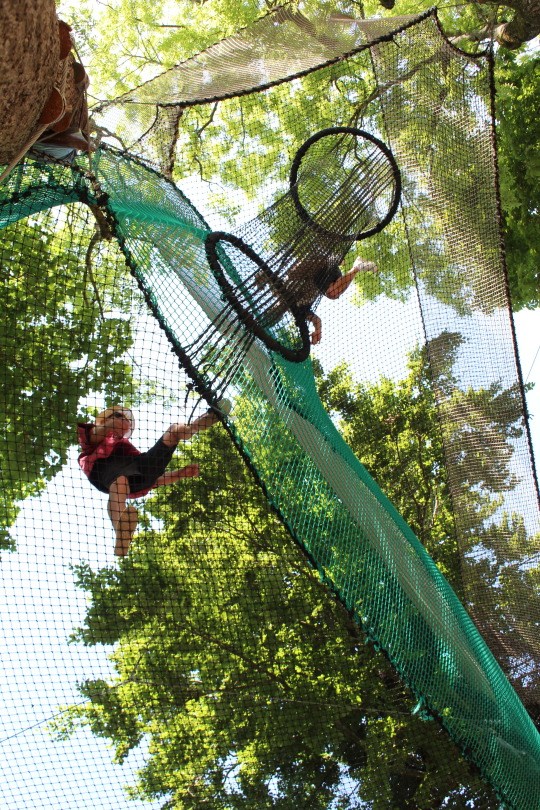
It did rain one day.
It drizzled most of the day.
It was marvellous.
We walked across the river to a champagne village named Oeuilly to visit the ‘Maison Champagnoise Musee’.
Apart from winning the prize for the most head-scratchingly-creative English translation pages (must have been done by the work exchange student back in 1998) this mannequin exhibited at the Musee is a podium contender for our Museum Mannequin 2022 award.

The competition is hotting up.
Like the weather.
The never ending heatwave was closing canals all over France.
We arrived in Chalons-en-Champagne and could go no further towards our goal of wintering in Strasbourg. In 2018 when we were last here ice was our problem, now it is lack of rain.
Chalons is a great town. It used to be called Chalons-sur-Marne and was mentioned as far back as 451 when the battle of Chalons turned back Attila. It is also notable as the crash site of of Snoopy when he fought the Red Baron! Incroyable!
In the main square is the most fanciful carousel ever.


The nearby Jard was hosting a free 3 day music festival for female musicians. On Friday night we joined the locals to watch the mostly fantastic musicians.
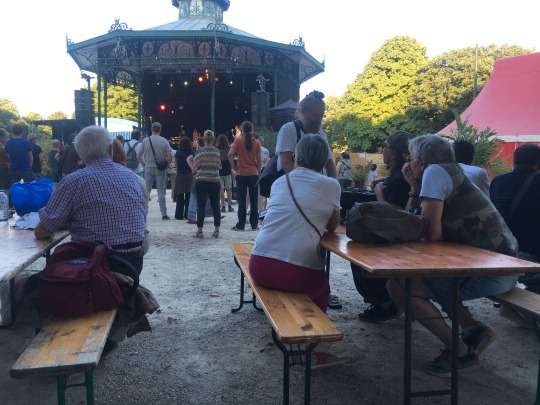
Our position on the pontoon meant we were part of the festival whether we visited it or not. It was too hot to do anything else but enjoy the music.
Chalons also boasts a ‘Musee des Beaux-arts et d’Archeologie’ which includes a collection of almost 3000 stuffed birds from all around the world. They exuded a spooky kind of charm.
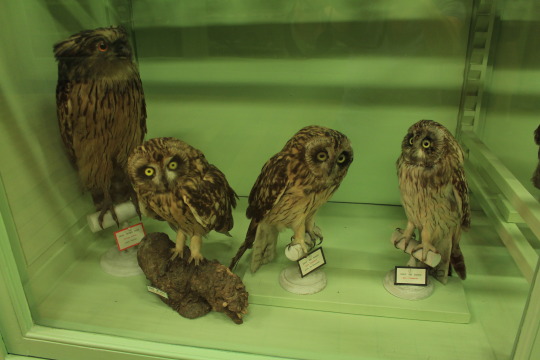
Moi avec lyre birds. All of us a very long way from home.

It was very nice to see this self portrait by Aline Hurault de Sorbée from the Musee celebrated in the busy Jardin area.
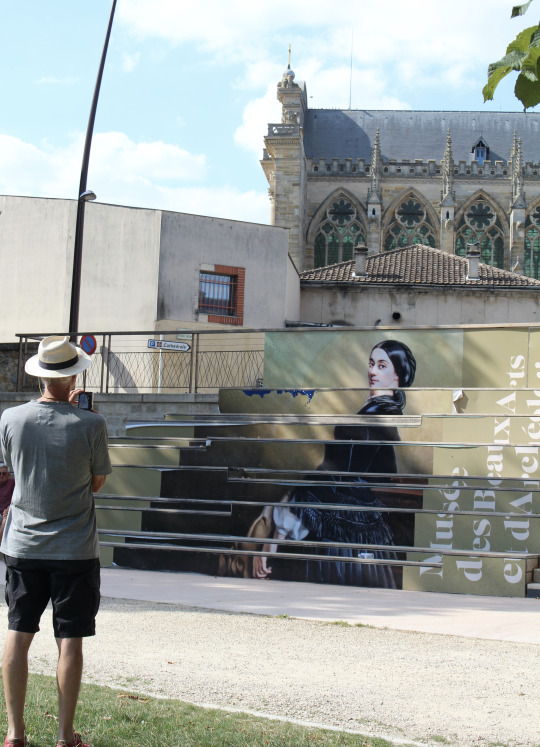
We would like to travel from left to right (west to east) to Strasbourg but as the map shows our way is all red and ‘You shall not pass!’
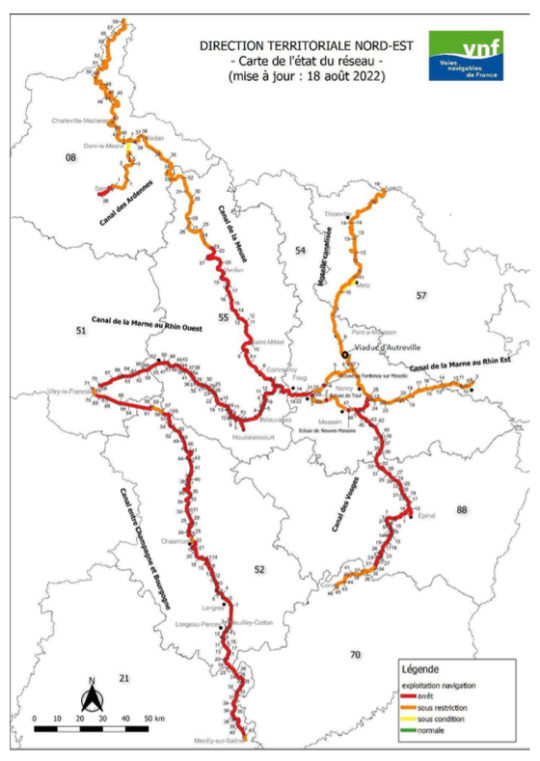
Doights croisés some of the canals will return to green as August passes to a cooler September.
2 notes
·
View notes
Note
Omg, Vanitas bites/marks requester here. I love these HCs so much. Thank you!! What a great way to start summer. :D
Haaaa I’m happy you liked it ! I liked it as well fufu~
I hope you don’t/didn’t have heatwave like we did in Belgium and enjoy your summer Sweetheart ! Don’t forget to stay hydrated !
8 notes
·
View notes
Text
Here's how 12,000-year-old weather can help us predict future changes in the climate
https://sciencespies.com/environment/heres-how-12000-year-old-weather-can-help-us-predict-future-changes-in-the-climate/
Here's how 12,000-year-old weather can help us predict future changes in the climate
The end of the last ice age, around 12,000 years ago, was characterised by a final cold phase called the Younger Dryas. Scandinavia was still mostly covered in ice, and across Europe the mountains had many more, and larger, glaciers than today. There was a substantial icefield in the west of Scotland and glaciers could be found on many mountains across the British Isles.
Not surprisingly, the climate was colder back then, especially in winter, with temperatures in the UK getting down to -30°C or lower.
Despite these freezing ice-age winters, differences in the Earth’s orbit around the Sun meant the summers were relatively warm, with an average temperature in July between 7°C and 10°C across most of the UK and Ireland.
Then, as now, the polar front jet stream (a high-altitude fast-moving wind belt) had a major influence on the weather across Europe, bringing precipitation (rain and snow) from the Atlantic across the continent.
However, before the time of written climate records, the timing, quantity and pattern of precipitation are poorly understood.
Our new study has used glaciers that existed during the Younger Dryas to determine the precipitation patterns and path of the jet stream across Europe at that time.
We identified glacial landforms called moraines at 122 sites from Morocco in the south to Norway in the north, and from Ireland in the west to Turkey in the east, which demonstrated the presence of glaciers some 12,000 years ago.
We reconstructed the 3D geometry of each of these glaciers using knowledge of the way that ice flows across the landscape.
From the reconstructed ice surfaces, we could determine an important point on each of these glaciers, the equilibrium line altitude which is linked to climate via yearly precipitation and average summer temperature.
It is essentially the altitude on the glacier where snow accumulation and snow melt are equal at the end of September and can be seen as the snowline.
The results provided a map of precipitation across Europe about 12,000 years ago which was controlled by the jet stream.
Jet stream weather
What the results showed was that the UK, Ireland, Portugal, and Spain were mostly wetter than the present day, as was the Mediterranean, especially in the east – the Balkans, Greece, and Turkey.
It was relatively drier across much of France, Belgium, the Netherlands, Germany, and farther east across Europe. These areas of wetter and drier climate allowed us to identify the location of the jet stream.
We surmised that the jet stream passed over the wetter regions bringing with it the storms (known as mid-latitude depressions) we are all familiar with in the UK – especially Scotland – and also potentially generated other smaller, more intense storms.
Based on the path of the jet stream it is believed that the autumn and spring were wettest in the UK and Ireland and that the winters were drier.
Across Portugal, Spain, and the Mediterranean, the winter months were probably the wettest, with autumn and spring being somewhat drier.
This is the first time that we have had an insight into the seasonal weather patterns across Europe during the Younger Dryas, and indeed such glimpses of past climate, beyond the period for which we have recorded climate observations, are rare.
Normally it is only numerical climate models that reveal such a regional scale view on past atmospheric circulation, storm tracks, and precipitation.
Numerical climate models plot our weather and climate by dividing the atmosphere, Earth’s surface and ocean into multiple interconnected cells, vertically and horizontally, in a three-dimensional grid, and solve complex mathematical equations to determine how energy and matter move through the system.
Changing jet stream
In our study, a comparison of the glacier-derived precipitation from 12,000 years ago was made with the outputs from several palaeoclimate (the study of climate in the past) computer simulations.
Numerical climate models are extremely complex, yet they remain a simplification of reality, so different models inevitably generate outputs which variously agree and disagree.
The general pattern of precipitation determined from our study of the palaeo-glaciers agreed with some parts of the climate model outputs, but in disagreement with others – for example, none of the climate models identified all of the UK, Ireland, Portugal, Spain and Mediterranean as being wetter in the past.
We are already seeing signs that the jet stream may be changing as the climate warms and it is thought that it will probably move northwards and become wavier.
These ripples could lead to more extremes, for example, heatwaves in summer and more storms and flooding in the winter.
To understand how climate will change in the future we rely on computer models, but these models do not yet agree on what happened in the past nor on exactly what will happen in the future.
To make better future predictions from ongoing climate warming, palaeoclimate datasets, such as the glacier-derived precipitation determined from our study, can be used to test the computer models.
When the models can better reproduce precipitation patterns reconstructed from past climates, especially in periods when the jet stream has moved, then our confidence in their predictions of future climate will also be boosted.
Brice Rea, Professor, Geography, University of Aberdeen.
This article is republished from The Conversation under a Creative Commons license. Read the original article.
#Environment
0 notes
Text
Record-breaking heatwave temperature confirmed

Image copyright Joe Giddens
Image caption People in Cambridge took to the river to escape the heat
The UK’s highest-ever temperature has been officially recorded in Cambridge, the Met Office has confirmed.
Cambridge University Botanic Garden measured 38.7C (101.7F) on Thursday beating the previous UK record of 38.5C (101.3F), set in Kent in 2003.
A Met Office official was sent to check the equipment before verifying the new record on Monday.
Staff working at the garden on Thursday tweeted: “No wonder we all felt as if we’d melted.”
Daily temperatures have been measured by the weather station at the site in the south of the city since 1904.

Horticultural team member Katie Martyr, who took the reading on Friday morning, said: “I thought straight away it was incredibly high but not in my wildest dreams did I think it would be the highest ever moment.
“It felt like an out-of-body experience.”

Image copyright CUBG
Image caption The weather station is monitored on a daily basis
Sally Petitt, head of horticulture, said: “To have recorded… the highest UK temperature ever serves as a further reminder that we all need to be taking climate change and its impacts seriously.”

Image copyright CUBG
Image caption A board at the botanic garden showed the record-breaking temperature
The high temperature means the UK joins Belgium, Germany and the Netherlands in breaking national records as exceptionally high temperatures gripped large parts of central and western Europe last week.
Cambridge University Botanic Garden director, Beverley Glover, said: “We are really pleased that our careful recording of the weather, something that we’ve been doing every day for over 100 years at the Botanic Garden, has been useful to the Met Office in defining the scale of this latest heatwave.
“Our long history of weather recording is very important to researchers analysing climate change.
“However, we can’t help but feel dismay at the high temperature recorded and the implication that our local climate is getting hotter, with inevitable consequences for the plants and animals around us.”
The hot weather last week caused major travel disruption across England and Wales.

Image caption Rail carriages had to be evacuated after two trains got stuck near Peterborough
Rail carriages had to be evacuated after two trains got stuck near Peterborough, Cambridgeshire, because of damage to overhead cables caused by the hot weather
A spokesman for London North Eastern Railway (LNER) said “record high temperatures have caused several incidents on the East Coast route”.
The risk that rail tracks would buckle in the heat disrupted train services between Cardiff Central and London Paddington.
Great Western also cancelled trains between London, Cardiff and Swansea.
The government’s advisory Committee on Climate Change has warned the UK is not prepared for the increase in heatwaves that is expected with global warming.
Earlier this summer, it called for more action to make sure homes and other buildings such as hospitals and care facilities could be comfortable and safe in higher temperatures.
Related Topics
Cambridge
Original Article : HERE ;
Record-breaking heatwave temperature confirmed was originally posted by MetNews
0 notes
Text
Joe’s Weather World: Easing through summer (WED-7/24)
Happy Wednesday…with another very comfortable start in the KC area this morning. Unlike yesterday when we briefly touched 57° to tie a previous record low…today we missed it by a couple of degrees. The record stands at 57° set back in 2004. The forecast is overall a dry one through the weekend…but there are small chances of some rain drops out there later tomorrow or tomorrow night. The pattern for now is that we’re in NW flow and that means we need to watch for little disturbances coming down in that flow from the NW>SE. Sometimes they aren’t modeled well…and sometimes they can create little showers or sprinkles.
Forecast:
Today: Some morning clouds but otherwise mostly sunny and mild with highs 80-85°
Tonight: Fair skies and pleasant with lows 60-65°
Thursday: Partly sunny with an outside chance that some light showers or sprinkles pop up somewhere out there. Highs near 85°
Friday: Mostly sunny and warmer with highs close to 85°
Discussion:
These last few days have been marvelous and today overall will be about the same. The main relief…temperatures and especially dew points are most welcome for this time year especially.
Dew points above 65° are typical…and above 70° aren’t that unusual…above 75° catches your attention.
Dew points in the 50s in late July is pretty unusual. Here is the 7AM surface map…
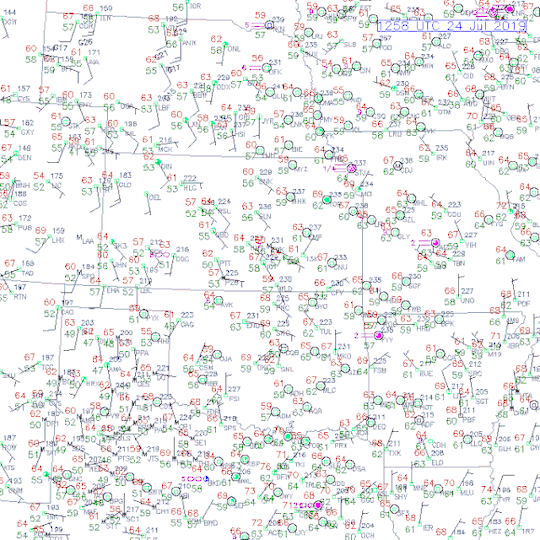
Dew points in most areas are in the upper 50s to near 60°
High pressure has moved into the Plains…
Compared to average though at 8AM…we’re still sitting pretty.

Air around a surface high circulates in a clockwise manner and blows away from higher pressure. Things are moving slowly so that this air mass is sort of just recirculating across the region right now. So the air isn’t getting too modified too quickly.
That means we’re just recirculating the same nice air…and when we broaden out the view to see the dew points across a wider area…
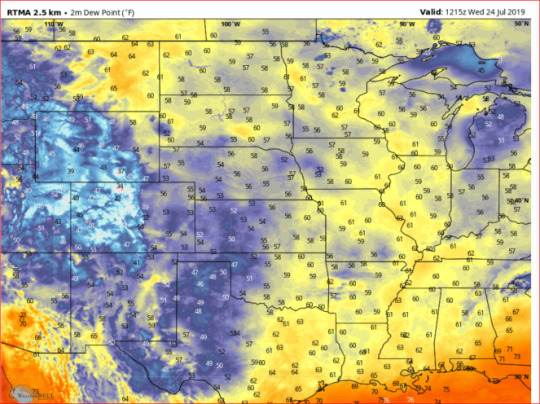
Again remember IF you have dew points in the 60-65° range…that is really pretty OK for late July..even the folks down in Dixie are enjoying this nice air as well compared to what things are typically like!
Where are the dew points higher? How about in the deserts of AZ.

This is some monsoonal moisture that has worked it’s way into south central AZ.
There have been some storms out there, especially in the more mountainous terrain. I’ve spent some time time talking about the fire burning north of Flagstaff in northern AZ. Yesterday I showed a fascinating timelapse of what happens when a fire is hit by a heavy thunderstorm and how it reacted to the rain that fell.
#MuseumFire Evening Update July 23, 2019 pic.twitter.com/mry80Le5Z1
— Arizona News (@ArizonaNewsnet) July 24, 2019
https://platform.twitter.com/widgets.js
Just for the heck of it, here's the #MuseumFire near #Flagstaff via Sentinel-2 satellite, taken 7/22/2019 18:24 UTC (False color/Urban image). Footprint of the fire is outdated. pic.twitter.com/AmGnrFPrfA
— AI6YR (@ai6yrham) July 24, 2019
https://platform.twitter.com/widgets.js
The thunderstorm brought so much rain so quickly that there was flash flooding in the area. What the concern is is that the fire has burning through vegetation and has left a “burn scar” on the land. When the rain falls you have tremendous runoff, there’s nothing that gets absorbed so you get flooding. So while the fire was burning you also have flash flood warnings and sand bagging operations happening to try to avoid the flooding issues. Crazy.
This was amazing to watch #azwx #azfamily pic.twitter.com/OVloDCsgPA
— Royal Norman (@royalnorman) July 24, 2019
https://platform.twitter.com/widgets.js
I would imagine though it was mostly welcome up there.
So far the overall fire season in the western US seems like it’s not starting off too crazy. There was a lot of moisture out there this winter…and now that things have dried out there are concerns about what happens down the road with human/lightning caused fires in the western third of the US.
While is seems things are going OK out in the western US (for now)…look what’s happening in AK.
#SuomiNPP continues to keep an eye on one of the worst wildfire seasons in Alaska. Over 2 million acres have burned so far. The 2 largest fires, Hess Creek and Chalkyitsik, can be seen in the far left and far right of this S-NPP image. More here: https://t.co/6g4zcZokfs pic.twitter.com/V3nr8axegI
— Joint Polar Satellite System (JPSS) (@JPSSProgram) July 24, 2019
https://platform.twitter.com/widgets.js
AK has been crazy warm (for them) all year long.
On the other side of the country 2 tornadoes hit the Cape Cod area yesterday including this dramatic video of a motel losing it’s roof from the strong winds. Wow!
Wow – incredible video of today's tornado from West Yarmouth. #nbcct pic.twitter.com/zJElc9At2h
— Ryan Hanrahan (@ryanhanrahan) July 23, 2019
https://platform.twitter.com/widgets.js
and on the other side of the Atlantic intense and potentially deadly heat continues in Europe. More all time record highs were set there yesterday and more may happen over the next few hours today. The temperature anomalies (up at about 5,000 feet) are pretty impressive in that part of the world. Remember most don’t have air conditioning there.

#France set new temperature records on Tuesday as temperatures topped 40°C. Many more heat records are expected in the next 2 days in countries including France, Germany, Belgium, NL, and possibly UK, during Europe's 2nd intense #heatwave of the year.#ClimateChange pic.twitter.com/PoAM3h4Ku3
— WMO | OMM (@WMO) July 24, 2019
https://platform.twitter.com/widgets.js
Second blast of intense heat on the way tomorrow across parts of Europe. Here's the current records v forecasted highs:

Netherlands: 38.6 / 40C

Belgium: 38.6 / 40C

Luxembourg: 37.9 / 40C

Germany: 40.3 / 40C

France: 46 / 40C#ClimateChange pic.twitter.com/zIGS8AIATt
— Steffan Griffiths (@SteffGriff) July 24, 2019
https://platform.twitter.com/widgets.js
This is their 2nd major heat wave this summer. Some relief comes over the next few days (especially over the weekend) for a pretty decent swath of western Europe at least.
Well I think I’ve covered a lot of bases and a lot of terrain! I want to give you a heads up that I’ll be taking my annual golf vacation/trip to Arizona starting Saturday. So odds are there won’t be blogs for about 10 days or so. I’ll get another one or two done this week before I leave though.
Our feature photo comes from Lesa Wardrip

Joe
from FOX 4 Kansas City WDAF-TV | News, Weather, Sports https://fox4kc.com/2019/07/24/joes-weather-world-easing-through-summer-wed-7-24/
from Kansas City Happenings https://kansascityhappenings.wordpress.com/2019/07/24/joes-weather-world-easing-through-summer-wed-7-24/
0 notes
Text
EuroHockey 2019 final: peerless Belgium men storm to first title, 5-0 over Spain
By Rod Gilmour | Antwerp
On this evidence, only a major Tokyo heatwave stopping players in their tracks will halt Shane Mcleod’s fearsome team of Red Lions from becoming Olympic champions in 2020. Belgium hockey’s 2024 grand slam prediction could even ring true by next year.
Adding to their world title in another ruthless display of rapid, front-foot hockey, coupled with simplistic passing at pace, Belgium forged a first European title on another boisterous night inside the compact stadium here as Spain were put to the sword five times.
Of Belgium’s 22 goals across six matches, 10 players were on target, led by five apiece from Alexander Hendrickx and Tom Boon. Vincent Vanasch shone again in goal. It’s not hard to pick a tournament standout either: Victor Wegnez. This time, there was no need for his wonderful emotion and passion. Naturally the pair won goalkeeper and player of the tournament respectively.
Wegnez had helped Belgium reach the final following an epic comeback in the late stages of perhaps the sport’s best ever match of recent times, scoring three times in seven minutes.
And they were seemingly intent to carry on the onslaught within the first 90 seconds of the final, Quico Cortes forced into action with a timely stick save off Belgium’s first PC.
Cortes had to be in tune twice further inside eight minutes, first with a second Lions’ PC and then low down to his right.
Finally, Belgium found a way, John-John Dohmen tapping home from a three-pronged move down the right. Vanasch’s right boot then kept away Spain’s equaliser as a full throttle first quarter ended.
Belgium’s second, less than a minute into the second half, was as easy as it was delicate finishing by Florent Van Aubel, who angled past Cortes as if glancing to third man in cricket.
Amid the football-style atmosphere, a cricket score loomed two minutes later when Boon launched a flick and Belgium’s frenzied fans were ready to party.
A fourth before half-time from Emmanuel Stockbroekx sealed gloss and the Europop music ushered in welcome respite for the beleaguered Spanish.
Spain, whose tactics couldn’t dent this Belgian side, briefly rallied after the break but Vanasch was immovable. A fifth soon came via Hendrickx’s stick.
The MC asked for a slow Mexican wave ahead of the final quarter, totally in contrast to Belgium’s frantic pace on the field. The speed and flow naturally slowed in the final 15 minutes. And with 60 seconds left, the sell out crowd was on its feet ready to see their stars make European history for the first time.
Belgium lift the trophy! #EHC2019 pic.twitter.com/LBICr7fzrZ
— EuroHockey (@eurohockeyorg) August 24, 2019
Earlier, Holland were too good for Germany in the bronze medal match. Only a few years ago these two would have played the Euro final.
But the world and European finals have been Belgium’s hour – and they are fast turning their domination into potentially several years.
For the time being, they will have several months off. No need for the Olympic qualifiers for this brilliant outfit.
We will have full reports, colour and analysis in our September issue. Subscribe now!
Tagged Belgium, EuroHockey Championships, spain
(function(d, s, id) { var js, fjs = d.getElementsByTagName(s)[0]; if (d.getElementById(id)) return; js = d.createElement(s); js.id = id; js.src = 'https://connect.facebook.net/en_GB/sdk.js#xfbml=1&version=v2.12&appId=171111330367584&autoLogAppEvents=1'; fjs.parentNode.insertBefore(js, fjs); }(document, 'script', 'facebook-jssdk')); Source link . More news
via wordpress https://ift.tt/2ZqyQF4
0 notes
Link
An unprecedented outbreak of wildfires in the Arctic has sent smoke across Eurasia and released more carbon dioxide in two months than the Czech Republic or Belgium does in a year. As 44C heatwaves struck Europe, scientists observed more than 100 long-lasting, intense fires in the Arctic in June, the hottest month on record, and are seeing even more in July, according to Mark Parrington of the European Centre for Medium-Range Weather Forecasts. Mostly in Alaska and Russia, the infernos have collectively released more than 120 million tonnes of CO2, more than the annual output of most countries. It is the most carbon emitted since satellite monitoring began in the early 2000s. This will further exacerbate climate change and has sent smoke pouring toward more populated parts of the world. Pollutants can persist more than a month in the atmosphere and spread thousands of kilometres. “You ask people about the Arctic, they think ice, polar bears, a clean environment, but clearly that's changing and that's no longer the case,” Mr Parrington said. “It should be an alarm bell that something isn't right, but the way it could directly affect them is the long-range transfer of smoke pollution. I don't think it's getting as far as western Europe just yet but that could happen.” The huge amounts of carbon from the fires will exacerbate climate change Credit: Maxar Technologies via AP While some have estimated that up to half a million kilometres have burned worldwide this year, Russia has been especially hard hit. Already, dangerous levels of smoke pollution have been reported this week in the cities of Chelyabinsk, Tomsk and Novosibirsk, where a curtain of smog turned the daytime sun a deep red. The number of patients in some cardiac wards have reportedly doubled. Fires first erupted in the peatlands of northern Siberia in June and have been joined by blazes in the massive boreal forests south of the Arctic circle. More than 30,000 square kilometres of Russian territory are currently burning, already about as much as in 2018 and twice as much as in 2017. This has created a 4.5 million square kilometre “smoke lid” that reaches as far east as the Pacific Ocean and as far south as Kazakhstan. To the west, thick smoke haze has drifted into more populated parts of the country, obscuring the streets of cities like Yekaterinburg and Perm and being detected all the way in Kazan on the Volga River. “This morning I thought a rubbish bin was burning outside the window, but it hasn't passed, the smoke is staying there,” Yekaterinburg resident Yevgenia Panasyuk told local television. Impressive extent of heavy smoke across much of central Russia/Siberia, Alaska & Canada from numerous intense boreal & Arcticwildfires shows up in latest Copernicus Atmosphere Monitoring Service aerosol optical depth forecast https://t.co/N5E33mccshpic.twitter.com/br0kkT02HY— Mark Parrington (@m_parrington) July 24, 2019 Once rare in the cold, wet tundra and forests, fires in the Arctic, which is warming at twice the world average, have been flaring up with increasing frequency. The Copernicus satellite system has observed an average of 50 to 60 Arctic hotspots on summer days since it began monitoring in 2003. This summer it has been seeing about 250 per day. And while in the past Arctic blazes would typically go out in a few days, the duration of this year's fires, many of which of have been burning for nearly two months, is shocking, Mr Parrington said. The long-term effects could be dire. Already in June, fires began to deposit soot known as “black carbon” on Arctic sea ice, accelerating its melt. Russia has mobilised 2,715 personnel and 28 aircraft but they are only fighting fires in about 1,500 square kilometres of territory. A brush fire burns in South Anchorage, Alaska Credit: Loren Holmes/Anchorage Daily News via AP Like in Alaska and Canada, not all fires here receive a response. Since 2015, Russia has declined to combat blazes in vast, remote “control zones” unless they threaten towns. “The logic is clear, we need to save money,” the head of the Krasnoyarsk region said this month. But the policy of leaving fires alone until they spread to populated areas has resulted in an “environmental disaster at a national level,” Greenpeace Russia said on Friday. It claimed that hundreds of villages were within the control zones, calling on these boundaries to be redrawn and for the government to send additional firefighting forces to defend villages. Also on Friday, a study published in Science found that some Alaskan glaciers were melting 100 times faster than previously thought. Drawing on data about the terminus of a glacier in LeConte Bay collected by local high students since 1983, scientists scanned the glacier with sonar, radar and time-lapse cameras for two summers to discover that the underwater part of it was melting up to 16 feet per day in August. Their results have demonstrated that glaciers are more sensitive to warming ocean temperatures than researchers had known.
from Yahoo News - Latest News & Headlines https://ift.tt/2Gx1Ftc
0 notes
Link
An unprecedented outbreak of wildfires in the Arctic has sent smoke across Eurasia and released more carbon dioxide in two months than the Czech Republic or Belgium does in a year. As 44C heatwaves struck Europe, scientists observed more than 100 long-lasting, intense fires in the Arctic in June, the hottest month on record, and are seeing even more in July, according to Mark Parrington of the European Centre for Medium-Range Weather Forecasts. Mostly in Alaska and Russia, the infernos have collectively released more than 120 million tonnes of CO2, more than the annual output of most countries. It is the most carbon emitted since satellite monitoring began in the early 2000s. This will further exacerbate climate change and has sent smoke pouring toward more populated parts of the world. Pollutants can persist more than a month in the atmosphere and spread thousands of kilometres. “You ask people about the Arctic, they think ice, polar bears, a clean environment, but clearly that's changing and that's no longer the case,” Mr Parrington said. “It should be an alarm bell that something isn't right, but the way it could directly affect them is the long-range transfer of smoke pollution. I don't think it's getting as far as western Europe just yet but that could happen.” The huge amounts of carbon from the fires will exacerbate climate change Credit: Maxar Technologies via AP While some have estimated that up to half a million kilometres have burned worldwide this year, Russia has been especially hard hit. Already, dangerous levels of smoke pollution have been reported this week in the cities of Chelyabinsk, Tomsk and Novosibirsk, where a curtain of smog turned the daytime sun a deep red. The number of patients in some cardiac wards have reportedly doubled. Fires first erupted in the peatlands of northern Siberia in June and have been joined by blazes in the massive boreal forests south of the Arctic circle. More than 30,000 square kilometres of Russian territory are currently burning, already about as much as in 2018 and twice as much as in 2017. This has created a 4.5 million square kilometre “smoke lid” that reaches as far east as the Pacific Ocean and as far south as Kazakhstan. To the west, thick smoke haze has drifted into more populated parts of the country, obscuring the streets of cities like Yekaterinburg and Perm and being detected all the way in Kazan on the Volga River. “This morning I thought a rubbish bin was burning outside the window, but it hasn't passed, the smoke is staying there,” Yekaterinburg resident Yevgenia Panasyuk told local television. Impressive extent of heavy smoke across much of central Russia/Siberia, Alaska & Canada from numerous intense boreal & Arcticwildfires shows up in latest Copernicus Atmosphere Monitoring Service aerosol optical depth forecast https://t.co/N5E33mccshpic.twitter.com/br0kkT02HY— Mark Parrington (@m_parrington) July 24, 2019 Once rare in the cold, wet tundra and forests, fires in the Arctic, which is warming at twice the world average, have been flaring up with increasing frequency. The Copernicus satellite system has observed an average of 50 to 60 Arctic hotspots on summer days since it began monitoring in 2003. This summer it has been seeing about 250 per day. And while in the past Arctic blazes would typically go out in a few days, the duration of this year's fires, many of which of have been burning for nearly two months, is shocking, Mr Parrington said. The long-term effects could be dire. Already in June, fires began to deposit soot known as “black carbon” on Arctic sea ice, accelerating its melt. Russia has mobilised 2,715 personnel and 28 aircraft but they are only fighting fires in about 1,500 square kilometres of territory. A brush fire burns in South Anchorage, Alaska Credit: Loren Holmes/Anchorage Daily News via AP Like in Alaska and Canada, not all fires here receive a response. Since 2015, Russia has declined to combat blazes in vast, remote “control zones” unless they threaten towns. “The logic is clear, we need to save money,” the head of the Krasnoyarsk region said this month. But the policy of leaving fires alone until they spread to populated areas has resulted in an “environmental disaster at a national level,” Greenpeace Russia said on Friday. It claimed that hundreds of villages were within the control zones, calling on these boundaries to be redrawn and for the government to send additional firefighting forces to defend villages. Also on Friday, a study published in Science found that some Alaskan glaciers were melting 100 times faster than previously thought. Drawing on data about the terminus of a glacier in LeConte Bay collected by local high students since 1983, scientists scanned the glacier with sonar, radar and time-lapse cameras for two summers to discover that the underwater part of it was melting up to 16 feet per day in August. Their results have demonstrated that glaciers are more sensitive to warming ocean temperatures than researchers had known.
from Yahoo News - Latest News & Headlines https://ift.tt/2Gx1Ftc
0 notes
Link
An unprecedented outbreak of wildfires in the Arctic has sent smoke across Eurasia and released more carbon dioxide in two months than the Czech Republic or Belgium does in a year. As 44C heatwaves struck Europe, scientists observed more than 100 long-lasting, intense fires in the Arctic in June, the hottest month on record, and are seeing even more in July, according to Mark Parrington of the European Centre for Medium-Range Weather Forecasts. Mostly in Alaska and Russia, the infernos have collectively released more than 120 million tonnes of CO2, more than the annual output of most countries. It is the most carbon emitted since satellite monitoring began in the early 2000s. This will further exacerbate climate change and has sent smoke pouring toward more populated parts of the world. Pollutants can persist more than a month in the atmosphere and spread thousands of kilometres. “You ask people about the Arctic, they think ice, polar bears, a clean environment, but clearly that's changing and that's no longer the case,” Mr Parrington said. “It should be an alarm bell that something isn't right, but the way it could directly affect them is the long-range transfer of smoke pollution. I don't think it's getting as far as western Europe just yet but that could happen.” The huge amounts of carbon from the fires will exacerbate climate change Credit: Maxar Technologies via AP While some have estimated that up to half a million kilometres have burned worldwide this year, Russia has been especially hard hit. Already, dangerous levels of smoke pollution have been reported this week in the cities of Chelyabinsk, Tomsk and Novosibirsk, where a curtain of smog turned the daytime sun a deep red. The number of patients in some cardiac wards have reportedly doubled. Fires first erupted in the peatlands of northern Siberia in June and have been joined by blazes in the massive boreal forests south of the Arctic circle. More than 30,000 square kilometres of Russian territory are currently burning, already about as much as in 2018 and twice as much as in 2017. This has created a 4.5 million square kilometre “smoke lid” that reaches as far east as the Pacific Ocean and as far south as Kazakhstan. To the west, thick smoke haze has drifted into more populated parts of the country, obscuring the streets of cities like Yekaterinburg and Perm and being detected all the way in Kazan on the Volga River. “This morning I thought a rubbish bin was burning outside the window, but it hasn't passed, the smoke is staying there,” Yekaterinburg resident Yevgenia Panasyuk told local television. Impressive extent of heavy smoke across much of central Russia/Siberia, Alaska & Canada from numerous intense boreal & Arcticwildfires shows up in latest Copernicus Atmosphere Monitoring Service aerosol optical depth forecast https://t.co/N5E33mccshpic.twitter.com/br0kkT02HY— Mark Parrington (@m_parrington) July 24, 2019 Once rare in the cold, wet tundra and forests, fires in the Arctic, which is warming at twice the world average, have been flaring up with increasing frequency. The Copernicus satellite system has observed an average of 50 to 60 Arctic hotspots on summer days since it began monitoring in 2003. This summer it has been seeing about 250 per day. And while in the past Arctic blazes would typically go out in a few days, the duration of this year's fires, many of which of have been burning for nearly two months, is shocking, Mr Parrington said. The long-term effects could be dire. Already in June, fires began to deposit soot known as “black carbon” on Arctic sea ice, accelerating its melt. Russia has mobilised 2,715 personnel and 28 aircraft but they are only fighting fires in about 1,500 square kilometres of territory. A brush fire burns in South Anchorage, Alaska Credit: Loren Holmes/Anchorage Daily News via AP Like in Alaska and Canada, not all fires here receive a response. Since 2015, Russia has declined to combat blazes in vast, remote “control zones” unless they threaten towns. “The logic is clear, we need to save money,” the head of the Krasnoyarsk region said this month. But the policy of leaving fires alone until they spread to populated areas has resulted in an “environmental disaster at a national level,” Greenpeace Russia said on Friday. It claimed that hundreds of villages were within the control zones, calling on these boundaries to be redrawn and for the government to send additional firefighting forces to defend villages. Also on Friday, a study published in Science found that some Alaskan glaciers were melting 100 times faster than previously thought. Drawing on data about the terminus of a glacier in LeConte Bay collected by local high students since 1983, scientists scanned the glacier with sonar, radar and time-lapse cameras for two summers to discover that the underwater part of it was melting up to 16 feet per day in August. Their results have demonstrated that glaciers are more sensitive to warming ocean temperatures than researchers had known.
from Yahoo News - Latest News & Headlines https://ift.tt/2Gx1Ftc
0 notes
Link
An unprecedented outbreak of wildfires in the Arctic has sent smoke across Eurasia and released more carbon dioxide in two months than the Czech Republic or Belgium does in a year. As 44C heatwaves struck Europe, scientists observed more than 100 long-lasting, intense fires in the Arctic in June, the hottest month on record, and are seeing even more in July, according to Mark Parrington of the European Centre for Medium-Range Weather Forecasts. Mostly in Alaska and Russia, the infernos have collectively released more than 120 million tonnes of CO2, more than the annual output of most countries. It is the most carbon emitted since satellite monitoring began in the early 2000s. This will further exacerbate climate change and has sent smoke pouring toward more populated parts of the world. Pollutants can persist more than a month in the atmosphere and spread thousands of kilometres. “You ask people about the Arctic, they think ice, polar bears, a clean environment, but clearly that's changing and that's no longer the case,” Mr Parrington said. “It should be an alarm bell that something isn't right, but the way it could directly affect them is the long-range transfer of smoke pollution. I don't think it's getting as far as western Europe just yet but that could happen.” The huge amounts of carbon from the fires will exacerbate climate change Credit: Maxar Technologies via AP While some have estimated that up to half a million kilometres have burned worldwide this year, Russia has been especially hard hit. Already, dangerous levels of smoke pollution have been reported this week in the cities of Chelyabinsk, Tomsk and Novosibirsk, where a curtain of smog turned the daytime sun a deep red. The number of patients in some cardiac wards have reportedly doubled. Fires first erupted in the peatlands of northern Siberia in June and have been joined by blazes in the massive boreal forests south of the Arctic circle. More than 30,000 square kilometres of Russian territory are currently burning, already about as much as in 2018 and twice as much as in 2017. This has created a 4.5 million square kilometre “smoke lid” that reaches as far east as the Pacific Ocean and as far south as Kazakhstan. To the west, thick smoke haze has drifted into more populated parts of the country, obscuring the streets of cities like Yekaterinburg and Perm and being detected all the way in Kazan on the Volga River. “This morning I thought a rubbish bin was burning outside the window, but it hasn't passed, the smoke is staying there,” Yekaterinburg resident Yevgenia Panasyuk told local television. Impressive extent of heavy smoke across much of central Russia/Siberia, Alaska & Canada from numerous intense boreal & Arcticwildfires shows up in latest Copernicus Atmosphere Monitoring Service aerosol optical depth forecast https://t.co/N5E33mccshpic.twitter.com/br0kkT02HY— Mark Parrington (@m_parrington) July 24, 2019 Once rare in the cold, wet tundra and forests, fires in the Arctic, which is warming at twice the world average, have been flaring up with increasing frequency. The Copernicus satellite system has observed an average of 50 to 60 Arctic hotspots on summer days since it began monitoring in 2003. This summer it has been seeing about 250 per day. And while in the past Arctic blazes would typically go out in a few days, the duration of this year's fires, many of which of have been burning for nearly two months, is shocking, Mr Parrington said. The long-term effects could be dire. Already in June, fires began to deposit soot known as “black carbon” on Arctic sea ice, accelerating its melt. Russia has mobilised 2,715 personnel and 28 aircraft but they are only fighting fires in about 1,500 square kilometres of territory. A brush fire burns in South Anchorage, Alaska Credit: Loren Holmes/Anchorage Daily News via AP Like in Alaska and Canada, not all fires here receive a response. Since 2015, Russia has declined to combat blazes in vast, remote “control zones” unless they threaten towns. “The logic is clear, we need to save money,” the head of the Krasnoyarsk region said this month. But the policy of leaving fires alone until they spread to populated areas has resulted in an “environmental disaster at a national level,” Greenpeace Russia said on Friday. It claimed that hundreds of villages were within the control zones, calling on these boundaries to be redrawn and for the government to send additional firefighting forces to defend villages. Also on Friday, a study published in Science found that some Alaskan glaciers were melting 100 times faster than previously thought. Drawing on data about the terminus of a glacier in LeConte Bay collected by local high students since 1983, scientists scanned the glacier with sonar, radar and time-lapse cameras for two summers to discover that the underwater part of it was melting up to 16 feet per day in August. Their results have demonstrated that glaciers are more sensitive to warming ocean temperatures than researchers had known.
from Yahoo News - Latest News & Headlines https://ift.tt/2Gx1Ftc
0 notes
Link
An unprecedented outbreak of wildfires in the Arctic has sent smoke across Eurasia and released more carbon dioxide in two months than the Czech Republic or Belgium does in a year. As 44C heatwaves struck Europe, scientists observed more than 100 long-lasting, intense fires in the Arctic in June, the hottest month on record, and are seeing even more in July, according to Mark Parrington of the European Centre for Medium-Range Weather Forecasts. Mostly in Alaska and Russia, the infernos have collectively released more than 120 million tonnes of CO2, more than the annual output of most countries. It is the most carbon emitted since satellite monitoring began in the early 2000s. This will further exacerbate climate change and has sent smoke pouring toward more populated parts of the world. Pollutants can persist more than a month in the atmosphere and spread thousands of kilometres. “You ask people about the Arctic, they think ice, polar bears, a clean environment, but clearly that's changing and that's no longer the case,” Mr Parrington said. “It should be an alarm bell that something isn't right, but the way it could directly affect them is the long-range transfer of smoke pollution. I don't think it's getting as far as western Europe just yet but that could happen.” The huge amounts of carbon from the fires will exacerbate climate change Credit: Maxar Technologies via AP While some have estimated that up to half a million kilometres have burned worldwide this year, Russia has been especially hard hit. Already, dangerous levels of smoke pollution have been reported this week in the cities of Chelyabinsk, Tomsk and Novosibirsk, where a curtain of smog turned the daytime sun a deep red. The number of patients in some cardiac wards have reportedly doubled. Fires first erupted in the peatlands of northern Siberia in June and have been joined by blazes in the massive boreal forests south of the Arctic circle. More than 30,000 square kilometres of Russian territory are currently burning, already about as much as in 2018 and twice as much as in 2017. This has created a 4.5 million square kilometre “smoke lid” that reaches as far east as the Pacific Ocean and as far south as Kazakhstan. To the west, thick smoke haze has drifted into more populated parts of the country, obscuring the streets of cities like Yekaterinburg and Perm and being detected all the way in Kazan on the Volga River. “This morning I thought a rubbish bin was burning outside the window, but it hasn't passed, the smoke is staying there,” Yekaterinburg resident Yevgenia Panasyuk told local television. Impressive extent of heavy smoke across much of central Russia/Siberia, Alaska & Canada from numerous intense boreal & Arcticwildfires shows up in latest Copernicus Atmosphere Monitoring Service aerosol optical depth forecast https://t.co/N5E33mccshpic.twitter.com/br0kkT02HY— Mark Parrington (@m_parrington) July 24, 2019 Once rare in the cold, wet tundra and forests, fires in the Arctic, which is warming at twice the world average, have been flaring up with increasing frequency. The Copernicus satellite system has observed an average of 50 to 60 Arctic hotspots on summer days since it began monitoring in 2003. This summer it has been seeing about 250 per day. And while in the past Arctic blazes would typically go out in a few days, the duration of this year's fires, many of which of have been burning for nearly two months, is shocking, Mr Parrington said. The long-term effects could be dire. Already in June, fires began to deposit soot known as “black carbon” on Arctic sea ice, accelerating its melt. Russia has mobilised 2,715 personnel and 28 aircraft but they are only fighting fires in about 1,500 square kilometres of territory. A brush fire burns in South Anchorage, Alaska Credit: Loren Holmes/Anchorage Daily News via AP Like in Alaska and Canada, not all fires here receive a response. Since 2015, Russia has declined to combat blazes in vast, remote “control zones” unless they threaten towns. “The logic is clear, we need to save money,” the head of the Krasnoyarsk region said this month. But the policy of leaving fires alone until they spread to populated areas has resulted in an “environmental disaster at a national level,” Greenpeace Russia said on Friday. It claimed that hundreds of villages were within the control zones, calling on these boundaries to be redrawn and for the government to send additional firefighting forces to defend villages. Also on Friday, a study published in Science found that some Alaskan glaciers were melting 100 times faster than previously thought. Drawing on data about the terminus of a glacier in LeConte Bay collected by local high students since 1983, scientists scanned the glacier with sonar, radar and time-lapse cameras for two summers to discover that the underwater part of it was melting up to 16 feet per day in August. Their results have demonstrated that glaciers are more sensitive to warming ocean temperatures than researchers had known.
from Yahoo News - Latest News & Headlines https://ift.tt/2Gx1Ftc
0 notes
Link
An unprecedented outbreak of wildfires in the Arctic has sent smoke across Eurasia and released more carbon dioxide in two months than the Czech Republic or Belgium does in a year. As 44C heatwaves struck Europe, scientists observed more than 100 long-lasting, intense fires in the Arctic in June, the hottest month on record, and are seeing even more in July, according to Mark Parrington of the European Centre for Medium-Range Weather Forecasts. Mostly in Alaska and Russia, the infernos have collectively released more than 120 million tonnes of CO2, more than the annual output of most countries. It is the most carbon emitted since satellite monitoring began in the early 2000s. This will further exacerbate climate change and has sent smoke pouring toward more populated parts of the world. Pollutants can persist more than a month in the atmosphere and spread thousands of kilometres. “You ask people about the Arctic, they think ice, polar bears, a clean environment, but clearly that's changing and that's no longer the case,” Mr Parrington said. “It should be an alarm bell that something isn't right, but the way it could directly affect them is the long-range transfer of smoke pollution. I don't think it's getting as far as western Europe just yet but that could happen.” The huge amounts of carbon from the fires will exacerbate climate change Credit: Maxar Technologies via AP While some have estimated that up to half a million kilometres have burned worldwide this year, Russia has been especially hard hit. Already, dangerous levels of smoke pollution have been reported this week in the cities of Chelyabinsk, Tomsk and Novosibirsk, where a curtain of smog turned the daytime sun a deep red. The number of patients in some cardiac wards have reportedly doubled. Fires first erupted in the peatlands of northern Siberia in June and have been joined by blazes in the massive boreal forests south of the Arctic circle. More than 30,000 square kilometres of Russian territory are currently burning, already about as much as in 2018 and twice as much as in 2017. This has created a 4.5 million square kilometre “smoke lid” that reaches as far east as the Pacific Ocean and as far south as Kazakhstan. To the west, thick smoke haze has drifted into more populated parts of the country, obscuring the streets of cities like Yekaterinburg and Perm and being detected all the way in Kazan on the Volga River. “This morning I thought a rubbish bin was burning outside the window, but it hasn't passed, the smoke is staying there,” Yekaterinburg resident Yevgenia Panasyuk told local television. Impressive extent of heavy smoke across much of central Russia/Siberia, Alaska & Canada from numerous intense boreal & Arcticwildfires shows up in latest Copernicus Atmosphere Monitoring Service aerosol optical depth forecast https://t.co/N5E33mccshpic.twitter.com/br0kkT02HY— Mark Parrington (@m_parrington) July 24, 2019 Once rare in the cold, wet tundra and forests, fires in the Arctic, which is warming at twice the world average, have been flaring up with increasing frequency. The Copernicus satellite system has observed an average of 50 to 60 Arctic hotspots on summer days since it began monitoring in 2003. This summer it has been seeing about 250 per day. And while in the past Arctic blazes would typically go out in a few days, the duration of this year's fires, many of which of have been burning for nearly two months, is shocking, Mr Parrington said. The long-term effects could be dire. Already in June, fires began to deposit soot known as “black carbon” on Arctic sea ice, accelerating its melt. Russia has mobilised 2,715 personnel and 28 aircraft but they are only fighting fires in about 1,500 square kilometres of territory. A brush fire burns in South Anchorage, Alaska Credit: Loren Holmes/Anchorage Daily News via AP Like in Alaska and Canada, not all fires here receive a response. Since 2015, Russia has declined to combat blazes in vast, remote “control zones” unless they threaten towns. “The logic is clear, we need to save money,” the head of the Krasnoyarsk region said this month. But the policy of leaving fires alone until they spread to populated areas has resulted in an “environmental disaster at a national level,” Greenpeace Russia said on Friday. It claimed that hundreds of villages were within the control zones, calling on these boundaries to be redrawn and for the government to send additional firefighting forces to defend villages. Also on Friday, a study published in Science found that some Alaskan glaciers were melting 100 times faster than previously thought. Drawing on data about the terminus of a glacier in LeConte Bay collected by local high students since 1983, scientists scanned the glacier with sonar, radar and time-lapse cameras for two summers to discover that the underwater part of it was melting up to 16 feet per day in August. Their results have demonstrated that glaciers are more sensitive to warming ocean temperatures than researchers had known.
from Yahoo News - Latest News & Headlines
0 notes
Text
Climate change warning as Arctic Circle burning at record rate
An unprecedented outbreak of wildfires in the Arctic has sent smoke across Eurasia and released more carbon dioxide in two months than the Czech Republic or Belgium does in a year. As 44C heatwaves struck Europe, scientists observed more than 100 long-lasting, intense fires in the Arctic in June, the hottest month on record, and are seeing even more in July, according to Mark Parrington of the European Centre for Medium-Range Weather Forecasts. Mostly in Alaska and Russia, the infernos have collectively released more than 120 million tonnes of CO2, more than the annual output of most countries. It is the most carbon emitted since satellite monitoring began in the early 2000s. This will further exacerbate climate change and has sent smoke pouring toward more populated parts of the world. Pollutants can persist more than a month in the atmosphere and spread thousands of kilometres. “You ask people about the Arctic, they think ice, polar bears, a clean environment, but clearly that's changing and that's no longer the case,” Mr Parrington said. “It should be an alarm bell that something isn't right, but the way it could directly affect them is the long-range transfer of smoke pollution. I don't think it's getting as far as western Europe just yet but that could happen.” The huge amounts of carbon from the fires will exacerbate climate change Credit: Maxar Technologies via AP While some have estimated that up to half a million kilometres have burned worldwide this year, Russia has been especially hard hit. Already, dangerous levels of smoke pollution have been reported this week in the cities of Chelyabinsk, Tomsk and Novosibirsk, where a curtain of smog turned the daytime sun a deep red. The number of patients in some cardiac wards have reportedly doubled. Fires first erupted in the peatlands of northern Siberia in June and have been joined by blazes in the massive boreal forests south of the Arctic circle. More than 30,000 square kilometres of Russian territory are currently burning, already about as much as in 2018 and twice as much as in 2017. This has created a 4.5 million square kilometre “smoke lid” that reaches as far east as the Pacific Ocean and as far south as Kazakhstan. To the west, thick smoke haze has drifted into more populated parts of the country, obscuring the streets of cities like Yekaterinburg and Perm and being detected all the way in Kazan on the Volga River. “This morning I thought a rubbish bin was burning outside the window, but it hasn't passed, the smoke is staying there,” Yekaterinburg resident Yevgenia Panasyuk told local television. Impressive extent of heavy smoke across much of central Russia/Siberia, Alaska & Canada from numerous intense boreal & Arcticwildfires shows up in latest Copernicus Atmosphere Monitoring Service aerosol optical depth forecast https://t.co/N5E33mccshpic.twitter.com/br0kkT02HY— Mark Parrington (@m_parrington) July 24, 2019 Once rare in the cold, wet tundra and forests, fires in the Arctic, which is warming at twice the world average, have been flaring up with increasing frequency. The Copernicus satellite system has observed an average of 50 to 60 Arctic hotspots on summer days since it began monitoring in 2003. This summer it has been seeing about 250 per day. And while in the past Arctic blazes would typically go out in a few days, the duration of this year's fires, many of which of have been burning for nearly two months, is shocking, Mr Parrington said. The long-term effects could be dire. Already in June, fires began to deposit soot known as “black carbon” on Arctic sea ice, accelerating its melt. Russia has mobilised 2,715 personnel and 28 aircraft but they are only fighting fires in about 1,500 square kilometres of territory. A brush fire burns in South Anchorage, Alaska Credit: Loren Holmes/Anchorage Daily News via AP Like in Alaska and Canada, not all fires here receive a response. Since 2015, Russia has declined to combat blazes in vast, remote “control zones” unless they threaten towns. “The logic is clear, we need to save money,” the head of the Krasnoyarsk region said this month. But the policy of leaving fires alone until they spread to populated areas has resulted in an “environmental disaster at a national level,” Greenpeace Russia said on Friday. It claimed that hundreds of villages were within the control zones, calling on these boundaries to be redrawn and for the government to send additional firefighting forces to defend villages. Also on Friday, a study published in Science found that some Alaskan glaciers were melting 100 times faster than previously thought. Drawing on data about the terminus of a glacier in LeConte Bay collected by local high students since 1983, scientists scanned the glacier with sonar, radar and time-lapse cameras for two summers to discover that the underwater part of it was melting up to 16 feet per day in August. Their results have demonstrated that glaciers are more sensitive to warming ocean temperatures than researchers had known.
from Yahoo News - Latest News & Headlines https://ift.tt/2Gx1Ftc via IFTTT
from Blogger https://ift.tt/2MjdPt7
0 notes
Link
An unprecedented outbreak of wildfires in the Arctic has sent smoke across Eurasia and released more carbon dioxide in two months than the Czech Republic or Belgium does in a year. As 44C heatwaves struck Europe, scientists observed more than 100 long-lasting, intense fires in the Arctic in June, the hottest month on record, and are seeing even more in July, according to Mark Parrington of the European Centre for Medium-Range Weather Forecasts. Mostly in Alaska and Russia, the infernos have collectively released more than 120 million tonnes of CO2, more than the annual output of most countries. It is the most carbon emitted since satellite monitoring began in the early 2000s. This will further exacerbate climate change and has sent smoke pouring toward more populated parts of the world. Pollutants can persist more than a month in the atmosphere and spread thousands of kilometres. “You ask people about the Arctic, they think ice, polar bears, a clean environment, but clearly that's changing and that's no longer the case,” Mr Parrington said. “It should be an alarm bell that something isn't right, but the way it could directly affect them is the long-range transfer of smoke pollution. I don't think it's getting as far as western Europe just yet but that could happen.” The huge amounts of carbon from the fires will exacerbate climate change Credit: Maxar Technologies via AP While some have estimated that up to half a million kilometres have burned worldwide this year, Russia has been especially hard hit. Already, dangerous levels of smoke pollution have been reported this week in the cities of Chelyabinsk, Tomsk and Novosibirsk, where a curtain of smog turned the daytime sun a deep red. The number of patients in some cardiac wards have reportedly doubled. Fires first erupted in the peatlands of northern Siberia in June and have been joined by blazes in the massive boreal forests south of the Arctic circle. More than 30,000 square kilometres of Russian territory are currently burning, already about as much as in 2018 and twice as much as in 2017. This has created a 4.5 million square kilometre “smoke lid” that reaches as far east as the Pacific Ocean and as far south as Kazakhstan. To the west, thick smoke haze has drifted into more populated parts of the country, obscuring the streets of cities like Yekaterinburg and Perm and being detected all the way in Kazan on the Volga River. “This morning I thought a rubbish bin was burning outside the window, but it hasn't passed, the smoke is staying there,” Yekaterinburg resident Yevgenia Panasyuk told local television. Impressive extent of heavy smoke across much of central Russia/Siberia, Alaska & Canada from numerous intense boreal & Arcticwildfires shows up in latest Copernicus Atmosphere Monitoring Service aerosol optical depth forecast https://t.co/N5E33mccshpic.twitter.com/br0kkT02HY— Mark Parrington (@m_parrington) July 24, 2019 Once rare in the cold, wet tundra and forests, fires in the Arctic, which is warming at twice the world average, have been flaring up with increasing frequency. The Copernicus satellite system has observed an average of 50 to 60 Arctic hotspots on summer days since it began monitoring in 2003. This summer it has been seeing about 250 per day. And while in the past Arctic blazes would typically go out in a few days, the duration of this year's fires, many of which of have been burning for nearly two months, is shocking, Mr Parrington said. The long-term effects could be dire. Already in June, fires began to deposit soot known as “black carbon” on Arctic sea ice, accelerating its melt. Russia has mobilised 2,715 personnel and 28 aircraft but they are only fighting fires in about 1,500 square kilometres of territory. A brush fire burns in South Anchorage, Alaska Credit: Loren Holmes/Anchorage Daily News via AP Like in Alaska and Canada, not all fires here receive a response. Since 2015, Russia has declined to combat blazes in vast, remote “control zones” unless they threaten towns. “The logic is clear, we need to save money,” the head of the Krasnoyarsk region said this month. But the policy of leaving fires alone until they spread to populated areas has resulted in an “environmental disaster at a national level,” Greenpeace Russia said on Friday. It claimed that hundreds of villages were within the control zones, calling on these boundaries to be redrawn and for the government to send additional firefighting forces to defend villages. Also on Friday, a study published in Science found that some Alaskan glaciers were melting 100 times faster than previously thought. Drawing on data about the terminus of a glacier in LeConte Bay collected by local high students since 1983, scientists scanned the glacier with sonar, radar and time-lapse cameras for two summers to discover that the underwater part of it was melting up to 16 feet per day in August. Their results have demonstrated that glaciers are more sensitive to warming ocean temperatures than researchers had known.
from Yahoo News - Latest News & Headlines https://ift.tt/2Gx1Ftc
0 notes